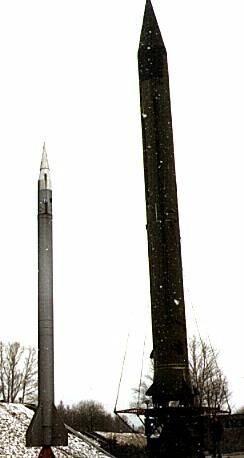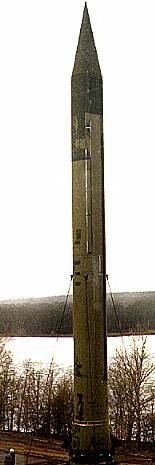Kosmos 2 (original) (raw)

Home - Search - Browse - Alphabetic Index: 0- 1- 2- 3- 4- 5- 6- 7- 8- 9
A- B- C- D- E- F- G- H- I- J- K- L- M- N- O- P- Q- R- S- T- U- V- W- X- Y- Z
Kosmos 2
Ukrainian orbital launch vehicle. In 1960 the Soviet government decreed development of a lightweight launch vehicle for launch of payloads not requiring R-7 family of boosters. A modification of the R-12 IRBM was selected as the first stage; a new high-performance second stage was developed using a unique LOx/UDMH propellant combination. After two failures, the first successful flight was on March 16, 1962.
Status: Retired 1977. First Launch: 1965-10-19. Last Launch: 1977-06-18. Number: 127 .
Serious consideration of designs for a Soviet light orbital launch vehicle began in the mid-fifties. At the end of 1956 Korolev studied a scientific launch vehicle based on an R-5 first stage and R-11 second stage. He concluded that it could only be used as a sounding rocket, that a new third stage would have to be developed for the combination to have orbital capability.
Yangel studied use of either the R-5M or the R-12 with various 'off the shelf' missile stages developed for surface-to-air missiles, but found that no such combination could reach orbit. Use of the R-12 in parallel stages was also possible, but the problem of in-flight ignition of the core stage was one not solved in the Soviet Union until 1955. Solid rockets available in the Soviet Union at that time had too low a specific impulse and too high a mass fraction to be useful in a satellite launcher. The only solution was a redesign of the R-12 to optimize it for the satellite launch role, and a small, new-design upper stage.
Korolev was anxious to move on to manned space exploration and was not interested in developing small launch vehicles. He was glad for Yangel to pursue this. However design work at Yangel's bureau was limited and desultory, since there was no outside support for the project until after the worldwide sensation following the launch of the first Sputnik in late 1957. But by then development of Yangel's R-16 ICBM had priority.
A key element in the development of a two-stage space launch vehicle was the solution of in-flight separation and ignition of the second stage following burn-out of the first stage. Yangel's R-16 ICBM was fitted with thrusters on the interstage between the first and second stages to provide thrust between shut-down of the first stage and ignition of the second. This kept the propellants in the tanks and the engine under G-force; there was no coasting period. The solution already adopted for some surface-to-air missiles - a 'hot start' where the second stage ignited while the first stage still was firing - was not adopted due to performance reasons.
Start-up of a rocket stage in zero-G was not solved until Korolev's Luna upper stage for the R-7. This was developed in response to a 20 March 1958 government resolution requiring the first launch of a Soviet probe to the moon within a year. In this period Glushko was developing the RD-109 engine for a high performance R-7 third stage. This burned liquid oxygen and UDMH propellants, achieving the astonishing specific impulse of 350 seconds. This would potentially double the payload compared to a liquid oxygen/kerosene stage. But the new technology engine was considered too much of a risk by Korolev. It also used the toxic hydrazine fuel he detested on principal. So on 10 October 1958 he gave Kosberg the task of developing a third stage engine for the R-7 derived from the R-7 first stage verniers and burning his preferred liquid oxygen/kerosene propellants. Meanwhile Glushko pursued further development of the RD-109, which used a 75 atmosphere chamber pressure and a closed engine cycle. By mid-1958 he had encountered various knotty problems in chamber cooling and the gas generator. It was decided to stop all work on the RD-109 in order to concentrate on development of the engines for the R-14 IRBM and R-16 ICBM. The estimated date for completion of development slipped to the end of 1959, too late for it to be used for the Vostok lunar launches. However it could be ready for the Vostok/Zenit manned and reconnaissance spacecraft orbital flights.
Development of the engine on tests stands was finally completed in January 1959, with runs in a 90 cubic meter vacuum chamber at a pressure of 1 mm Hg. The RD-109 that finally emerged had a chamber pressure of 76 to 70 atm and a specific impulse of 334 seconds. The conventional liquid oxygen/kerosene engine that Kosberg had developed as a replacement in the Luna probes (the RD-0105/RO-5) had a specific impulse of 316 seconds. Use of the RD-109 in the Luna stage would have increased payload to 424 kg as opposed to 373 kg with the RD-0105. But for use on the piloted Vostok booster, Korolev refused to consider using UDMH as a fuel due to its toxicity. Therefore he opted to further develop the Kosberg engine for the Vostok, leaving the RD-109 an engine without an application.
However Yangel saw that the engine would be a good match for a high-performance upper stage application. Therefore Glushko agreed to continue to refine the RD-109, now designated the RD-119. The new engine had many improvements in the chamber and nozzle profile and could run at higher chamber temperatures through the use of double-shell wall cooling. The result was a specific impulse of 352 seconds. The engine was run at up to 260 seconds firing durations as opposed to the 150 seconds rated ability.
A government resolution of 8 August 1960 authorized Yangel to develop the 63S1 light orbital launch vehicle for launch of payloads not requiring the R-7 family of boosters and to produce a series of ten for launch of small satellites. The booster had to use the existing R-12 IRBM as a first stage, the existing Mayak launch silo as a launcher, and an existing engine for the upper stage. Since the R-12 was built for silo launch (it could not be held on a surface pad exposed to the elements), the existing R-12 silo 'Mayak-2' at Kapustin Yar was adapted. A swing-back shelter above the top of silo covered the second stage and payload during launch preparations.
The 63S1 was used through May 1966 for a total of 40 launches, of which 12 were failures. The Mayak complex was built for missile launches and was not durable enough for repeated space launches. A space launch complex had to be a virtual 'launch chimney' and endure the flames of many launches and accommodate many different payloads. Therefore the Mayak complex was abandoned and the Voskhod and Raduga complexes were designed for later R-12 and R-14 derived space launchers. The same military cadres designed and built the R-7 Angara complex and missile sites.
More at: Kosmos 2.
Family: orbital launch vehicle. Country: Ukraine. Spacecraft: Project 581, DS-1, DS-2, 1MS, 2MS, DS-P1, DS-K-8, DS-A1, Omega, DS-MT, DS-MG, DS-P1-Yu, Strela-1, DS-U2-V, DS-U2-M, DS-K-40, DS-P1-I, DS-U1-G, DS-U2-I, DS-U2-MP, DS-U2-D, DS-MO, DS-U3-S, DS-U1-Ya, DS-U1-A, DS-U2-GK, DS-U2-GF, DS-U3-IK, DS-U1-IK, DS-U2-MG, DS-U1-R, DS-U2-IK. Agency: Yuzhnoye. Bibliography: 116, 2, 42, 474, 475, 476, 567, 6, 79, 89, 99.
Photo Gallery
 |
MR-12 rocketMR-12 sounding rocket and R-12 IRBM at KalugaCredit: © Mark Wade |
|---|
 |
Kosmos LVCredit: © Mark Wade |
|---|
End of 1953 - . LV Family: R-12. Launch Vehicle: Kosmos 2.
- Khrushchev and Ustinov decide to create additional independent missile design bureaux - . Nation: Russia. Related Persons: Khrushchev, Korolev, Makeyev, Ustinov, Yangel.
Khrushchev desired to decentralise the missile industry, since a single nuclear bomb on Moscow would wipe out Korolev's factories. Ustinov was requested to draw up a plan for two additional completely independent missile design bureaux, one in the south of the Soviet Union, the other in the Urals. It was also envisioned a third bureau would be built in the east, in Siberia, but this was never done. This effort cost tens of billions of roubles. While the managers and lead technical staff would be taken from Korolev's bureau, the working engineers, technicians, and workers for the bureau and associated factories would be recruited locally at each site. This would avoid the additional expense of building extra housing. Korolev fought to keep control, wanting to make the new bureaux just branches of his own, but Khrushchev was adamant that only completely autonomous organisations would be acceptable. Yangel was easily selected for the southern bureau, and the young Makeyev was a more contentious selection for the Ural bureau.
Home - Search - Browse - Alphabetic Index: 0- 1- 2- 3- 4- 5- 6- 7- 8- 9
A- B- C- D- E- F- G- H- I- J- K- L- M- N- O- P- Q- R- S- T- U- V- W- X- Y- Z
© 1997-2019 Mark Wade - Contact
© / Conditions for Use
